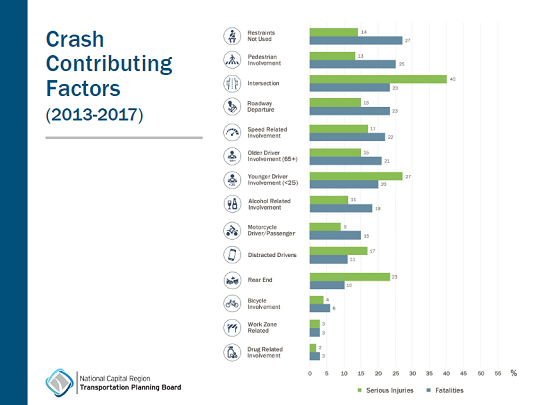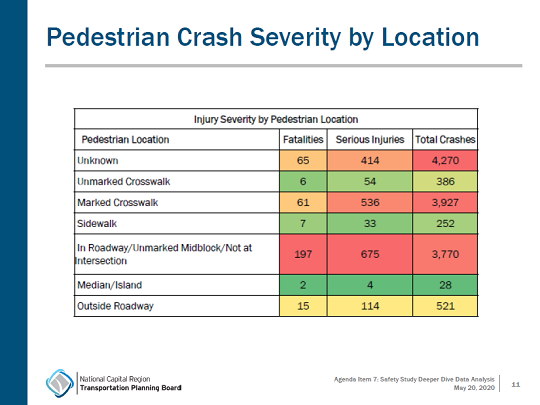The National Capital Region Transportation Planning Board (TPB) at the Metropolitan Washington Council of Governments is considering a set of recommendations to reduce injuries and fatalities on area roadways.
Among the recommendations being considered is a new TPB Regional Roadway Safety Program to assist member jurisdictions with equitably improving safety outcomes for all roadway users.
In addition, the recommendations urge TPB members to reaffirm road user safety as a top priority, work individually and collectively to implement a broad range of safety measures to address the most fatal and serious injury crashes, and encourage Vision Zero programs, seat belt legislation, and increased use of ignition interlock devices for impaired driving offenders.
The recommendations follow a year-long Regional Safety Study which analyzed the types of fatal and serious injury crashes in the region and the factors contributing to them.
“The TPB’s safety study revealed that the region’s most serious traffic incidents involve pedestrians, certain intersections and major arterials, and young drivers,” said Kelly Russell, TPB Chair and City of Frederick Alderman. “If we can commit to taking these actions as a region, I’m confident we will save lives.”
TPB will consider formally adopting the recommendations at its July meeting.
KEY FINDINGS FROM THE REGIONAL SAFETY STUDY
Although a full report on the Regional Safety Study is forthcoming, several key findings were first presented to the TPB in April.
An assessment of the data revealed that there are several underlying behavioral factors that contribute to fatalities and injuries, including not wearing seatbelts, speeding, impaired driving, and distracted driving.
The data also revealed that there are three types of crashes that account for a disproportionate share of fatalities and serious injuries—pedestrians, intersections, and major arterials.


Following a presentation of this initial analysis, additional data was presented to the TPB in May that further investigated these crashes between vehicles and pedestrians, crashes at or near intersections, and crashes along major arterials.
For example, data show a majority of pedestrian fatalities and serious injuries occur in the roadway and not at an intersection. Data show that most intersection crashes are at signalized intersections along arterials. And, data show that most of the fatalities and serious injuries along major arterials are associated with angle/left turn crashes.

The recommendations up for consideration by the TPB and voted on at the July 22 meeting will address these areas and more.
ABOUT THE REGIONAL SAFETY STUDY
To better understand the factors behind the unacceptable numbers of fatalities and serious injuries occurring on the region’s roadways each year, the TPB commissioned the Regional Safety Study.
Work on the study kicked off in June 2019, and was guided by a panel of TPB staff and safety officials from the District Department of Transportation, Maryland Department of Transportation, and Virginia Department of Transportation.
MORE:
TPB Safety Study Resources
TPB News: Not wearing a seat belt is a major factor in roadway fatalities